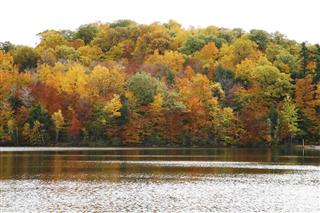
The autumn blaze maple’s problems start when the tree is planted in soil that doesn’t suit it and proper care is not taken, irrespective of the fact that this is quite a hardy tree.
The autumn blaze maple tree is actually a cultivar of the silver maple (Acer saccharinum) and red maple (Acer rubrum) and is scientifically known as Acer freemanii. The tree has a rounded oval form and its leaves resemble the leaves of the silver maple. The tree probably got the name ‘autumn blaze maple’ because of the attractive and desirable color of its foliage and fruit.
The autumn blaze maple tree has a regular and upright growth with production of a heavy number of fruits. The fruits of the autumn blaze are bright yellow in color and are edible. This autumn maple cultivar is a huge success as it contains all the desired qualities of maple trees in a single tree.
With all these qualities incorporated into this tree what kind of autumn blaze maple problems would you be expecting? Let’s find the problems associated with this tree as well as the diseases that this tree is prone to, which is essential to know so that you may take better care of it.
Problems with the Autumn Blaze Maple
Alkalinity.
This tree requires iron and magnesium for the formation of chlorophyll, the photosynthetic active green pigment that is found in the leaves of all green plants. When planted in alkaline soil, the plant doesn’t get the required amount of iron and magnesium. This results in less chlorophyll which is detrimental to the health of the autumn blaze maple. Smaller and new leaves are the most affected and as a result, they appear yellow with green veins.
At this time, the leaf’s cells are very weak and may die due to the lack of chlorophyll and the iron-magnesium combination. You can avoid this problem by adding iron and magnesium to the soil and by decreasing its alkalinity.
The tree requires proper care and thorough knowledge about the various problems that can affect it. The good news is that as it is a hybrid version of the maple tree, the autumn blaze maple is not prone to as many diseases as ordinary maple trees.
Nonetheless, there are certain maple tree diseases that can create problems with the autumn blaze maple. Though, similar to any other maple tree, the autumn blaze maple will fall prone to common diseases and attacks by insects, pests, and fungi. Here are the autumn blaze maple tree problems that one must know, in order to maintain good health of the plant.
Fusarium Wilt or Verticillium Wilt
Wilts are contracted by the autumn blaze maple tree through infected seeds, plant debris, or infected soil. It is a fungus that multiplies during the cold and moist season. As a result, the plants wilt because the water conducting mechanism of the plants are damaged by the fungi. Fertilization can make the problem even worse. As the fungus overwinters in soil, it can also be harbored into other common weeds.
To prevent this, one must try to cultivate species that are wilt resistant. Cut down the usage of nitrogen-heavy fertilizers and avoid over-irrigation. Removing the dead and damaged leaves through pruning is also very important.
Spider Mites
These small spider like mites tend to thrive in hot and dry conditions. The mites feed themselves by gorging on the plant’s parts, which is the reason why the autumn blaze maple starts to look pale yellow and stippled. Spider mites multiply quickly and can also create webs that can cover infested parts of the trees.
For prevention, the weeds need to be kept under control and infested plants destroyed. Water the plants regularly and exterminate the spider mites with an appropriate fertilizer.
Tar Spots
This is actually a harmless autumn blaze maple disease that is caused by fungus and pathogens. The disease doesn’t prove to be harmful to the health of the autumn blaze maple but it surely creates ugly looking tar spots on the leaves of the plants. At the beginning, these tar spots are pale yellow in color that later on turn dark. These tar spots affect the upper surface of the leaves during the spring season and as a result, the tree tends to shed its leaves, before fall.
Though the disease is not harmful and there is nothing much one can do to prevent it, you should remove the infected leaves when the tree seems dry and avoid overhead irrigation. Use some fungicide, only after reading the instructions on its label.
Others
Shore flies, fungus gnats, aphids, scale insects, and caterpillars are some of the other culprits that can create a few autumn blaze maple problems. To get rid of the above-mentioned, individual scouting is necessary. One must always supervise each plant and look for the presence of the above-mentioned troublemakers. On identifying them take proper but safe preventive measures, and that includes fertilizers.
There are a few things that can be performed to reduce the autumn blaze maple’s problems. The primary measure is to learn the proper techniques about maple tree planting and maple tree care. Through appropriate knowledge and proper care, one can definitely cultivate the tree the way one likes, without encountering too many problems on the way.







